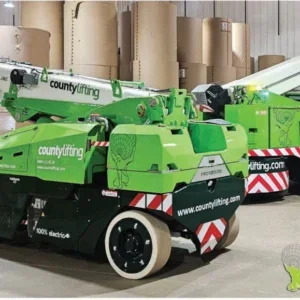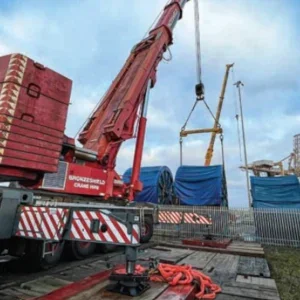Despite the increasing lifting capacity of cranes, strand jacking is often the only solution. Space constraints, equipment erection time or lifting capacity requirements, for example, often preclude the use of a crane.
One strand jacking specialist, Zalcon, promotes engineered strand jacking systems as the safest and most cost-effective solution for heavy lifting. Zalcon’s strand jacks are used all over the world instead of cranes, typically for applications in construction, petrochemical and the offshore industry. The company, founded by managing director Peter Lowther 15 years ago, operates from offices in the UK and Hong Kong.
Competition does come from larger cranes on jobs in the petrochemical industry but operations manager Michael Wade says it is not a problem in the company’s area of involvement. There might be some crossover in that, for example, Mammoet’s MSG 50 containerised lifting systems are not strictly cranes because they use strand jacks rather than winches to raise the load.
Advantages
A benefit of a strand jacking system over cranes, according to Wade, is that fewer containers are required for shipment. Crane companies say that the greater speed of a winch gives shorter lift times which is an advantage over jacking, particularly if there is a limited weather window. Zalcon says this is not a problem because its jacking system can lift loads at any speed up to 60m/hour and can be designed to work in wind speeds of more than 9m/second. Lifting at the higher rates is more expensive because larger power packs are needed and a more usual operating speed is 20m/hour. A further disadvantage of large cranes, Wade says, is that they need large foundations which involve more ground preparation than for a jacking system.
Wade also claims an inherent safety advantage ratio for strand jacking – however many falls of rope there are on a crane, there is still only a single rope to the winch, but a strand jacking system might have 51, for example, in a single jack. Zalcon also operates with a 2.5:1 factor of safety against the minimum breaking load, ie 38t is the minimum breaking load of a single strand but it is only rated with a SWL of 15t. Strands used by Zalcon are 18mm diameter pre-stressing wire for reinforced concrete. Bridon supplies it in coils weighing between 1t and 3t each, for which Zalcon has its own handling equipment.
A modular system of standard tower sections can often be used but Zalcon specialises in offering a complete engineered solution, including full design and supply of equipment, rather than just supplying a set of hydraulic jacks and some standard tower sections. Fabrication work is outsourced but all design and engineering is done in-house. Mammoet and PSC are major players in the sector and Zalcon has supplied its jacks to Alatas Mammoet, Sarens and Abnormal Load Engineering in the UK.
The jacks
Nine standard strand jack models are available in capacities ranging from 15t to 775t each. Zalcon’s jacks are designed for easier maintenance and more controlled operation. Access to all the strands, for example, is important. These are arranged in optimised circular patterns so that even strands right in the centre of the bundle can be reached if attention is needed.
The system uses double-acting mini-jacks for positive opening and closing of both top and bottom anchors rather than just relying on taking the load off the anchors to release them. A load is normally lowered under power but there is also a bleed system for fine lowering movements rather than powering the load down. A monitoring system for position on both the main and mini jacks is also fitted.
Automation is available, using a programmable logic controller, so that the cycling operation when the jacks are working does not need to be done manually. Most jacking systems have a fixed operating speed but Zalcon can supply a variable speed system, consisting of an electronic and hydraulic control module mounted with the jack. It also interconnects all the jacks so they can be synchronised.
When designing a lifting solution the preference is to use the smallest number of large jacks as opposed to a large number of small ones, but this is not always possible. The load might be a large roof section, for example, that is not rigid enough to be lifted from a single point.






